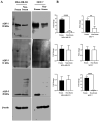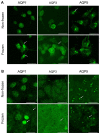Inhibition of aquaporins as a potential adjunct to breast cancer cryotherapy
- PMID: 33907568
- PMCID: PMC8063341
- DOI: 10.3892/ol.2021.12719
Inhibition of aquaporins as a potential adjunct to breast cancer cryotherapy
Abstract
Cryoablation is an emerging type of treatment for cancer. The sensitization of tumors using cryosensitizing agents prior to treatment enhances ablation efficiency and may improve clinical outcomes. Water efflux, which is regulated by aquaporin channels, contributes to cancer cell damage achieved through cryoablation. An increase in aquaporin (AQP) 3 is cryoprotective, whereas its inhibition augments cryodamage. The present study aimed to investigate aquaporin (AQP1, AQP3 and AQP5) gene expression and cellular localization in response to cryoinjury. Cultured breast cancer cells (MDA-MB-231 and MCF-7) were exposed to freezing to induce cryoinjury. RNA and protein extracts were then analyzed using reverse transcription-quantitative PCR and western blotting, respectively. Localization of aquaporins was studied using immunocytochemistry. Additionally, cells were transfected with small interfering RNA to silence aquaporin gene expression and cell viability was assessed using the Sulforhodamine B assay. Cryoinjury did not influence gene expression of AQPs, except for a 4-fold increase of AQP1 expression in MDA-MD-231 cells. There were no clear differences in AQP protein expression for either cell lines upon exposure to frozen and non-frozen temperatures, with the exception of fainter AQP5 bands for non-frozen MCF-7 cells. The exposure of cancer cells to freezing temperatures altered the localization of AQP1 and AQP3 proteins in both MCF-7 and MDA-MD-231 cells. The silencing of AQP1, AQP3 and AQP5 exacerbated MDA-MD-231 cell damage associated with freezing compared with control siRNA. This was also observed with AQP3 and AQP5 silencing in MCF-7 cells. Inhibition of aquaporins may potentially enhance cryoinjury. This cryosensitizing process may be used as an adjunct to breast cancer cryotherapy, especially in the border area targeted by cryoablation where freezing temperatures are not cold enough to induce cellular damage.
Keywords: aquaporins; breast cancer; cryoinjury; cryosensitization; cryotherapy.
Copyright: © Alkhalifa et al.
Conflict of interest statement
The authors declare that they have no competing interests.
Figures





Similar articles
-
Inhibition of the aquaporin 3 water channel increases the sensitivity of prostate cancer cells to cryotherapy.Br J Cancer. 2009 Jun 16;100(12):1889-95. doi: 10.1038/sj.bjc.6605093. Br J Cancer. 2009. PMID: 19513079 Free PMC article.
-
Expression of aquaporins in the rat ocular tissue.Exp Eye Res. 1997 Feb;64(2):203-9. doi: 10.1006/exer.1996.0196. Exp Eye Res. 1997. PMID: 9176054
-
Seasonal effect in expression of AQP1, AQP3 and AQP5 in skin of Murrah buffaloes.J Therm Biol. 2020 Oct;93:102727. doi: 10.1016/j.jtherbio.2020.102727. Epub 2020 Sep 11. J Therm Biol. 2020. PMID: 33077138
-
Aquaporins: New players in breast cancer progression and treatment response.Front Oncol. 2022 Sep 21;12:988119. doi: 10.3389/fonc.2022.988119. eCollection 2022. Front Oncol. 2022. PMID: 36212456 Free PMC article. Review.
-
Aquaporin water channels and lung physiology.Am J Physiol Lung Cell Mol Physiol. 2000 May;278(5):L867-79. doi: 10.1152/ajplung.2000.278.5.L867. Am J Physiol Lung Cell Mol Physiol. 2000. PMID: 10781416 Review.
Cited by
-
The role of Aquaporins in tumorigenesis: implications for therapeutic development.Cell Commun Signal. 2024 Feb 9;22(1):106. doi: 10.1186/s12964-023-01459-9. Cell Commun Signal. 2024. PMID: 38336645 Free PMC article. Review.
-
Recent progress in cryoablation cancer therapy and nanoparticles mediated cryoablation.Theranostics. 2022 Feb 14;12(5):2175-2204. doi: 10.7150/thno.67530. eCollection 2022. Theranostics. 2022. PMID: 35265206 Free PMC article. Review.
-
Clinical application status and prospect of the combined anti-tumor strategy of ablation and immunotherapy.Front Immunol. 2022 Sep 5;13:965120. doi: 10.3389/fimmu.2022.965120. eCollection 2022. Front Immunol. 2022. PMID: 36131929 Free PMC article. Review.
-
Utility of ferritin and inflammatory biomarkers in the diagnosis of different stages of breast cancer.Saudi Med J. 2021 Aug;42(8):825-831. doi: 10.15537/smj.2021.42.8.20210244. Saudi Med J. 2021. PMID: 34344805 Free PMC article.
-
Cryoablation for the treatment of breast cancer: immunological implications and future perspectives. Utopia or reality?Radiol Med. 2024 Feb;129(2):222-228. doi: 10.1007/s11547-024-01769-z. Epub 2024 Jan 31. Radiol Med. 2024. PMID: 38296892 Free PMC article. Review.
References
-
- Global Burden of Disease Cancer Collaboration. Fitzmaurice C, Allen C, Barber RM, Barregard L, Bhutta ZA, Brenner H, Dicker DJ, Chimed-Orchir O, Dandona R, et al. Global, regional, and national cancer incidence, mortality, years of life lost, years lived with disability, and disability-adjusted life-years for 32 cancer groups, 1990 to 2015: A systematic analysis for the global burden of disease study. JAMA Oncol. 2017;3:524–548. doi: 10.1001/jamaoncol.2016.5688. - DOI - PMC - PubMed
-
- PDQ Adult Treatment Editorial Board, corp-author. PDQ Cancer Information Summaries. National Cancer Institute (USA); Bethesda, MD: 2002. Breast cancer treatment (Adult) (PDQ®): Patient version.
LinkOut - more resources
Full Text Sources
Other Literature Sources
Miscellaneous
